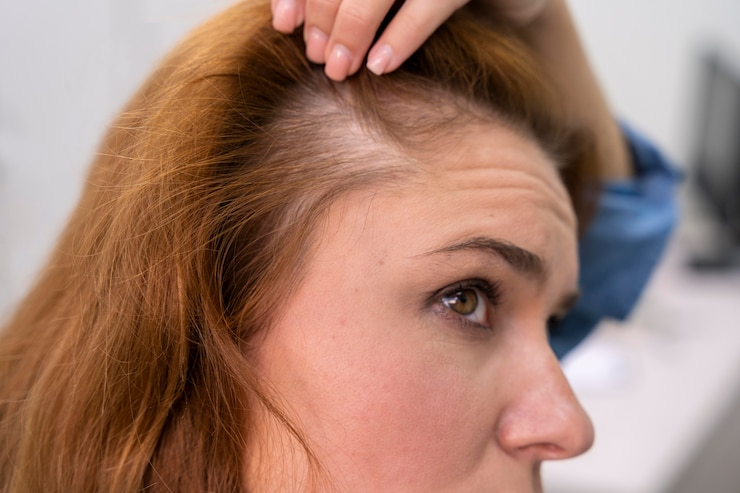When we think of hair loss, we often imagine men with receding hairlines or bald spots. But pattern baldness in women—also known as female pattern hair loss (FPHL)—is far more common than people think. In fact, millions of women worldwide experience this condition, and it’s often more emotionally distressing due to societal expectations around beauty and femininity.
If you or someone you know is experiencing hair thinning, here’s everything you need to know about pattern baldness in women—from causes to treatment options.
What Is Female Pattern Baldness?
Female pattern baldness is a gradual thinning of hair, especially on the top and crown of the scalp. Unlike male pattern baldness, women usually do not experience a receding hairline or total baldness. Instead, the parting becomes wider, and hair volume reduces over time.
This condition typically starts in women between the ages of 30 and 40, but it can begin earlier or later depending on genetics and hormonal changes.
Common Causes of Pattern Baldness in Women
1. Genetics
Just like men, women can inherit hair loss from either parent. If your mother or grandmother experienced thinning hair, your chances may be higher.
2. Hormonal Changes
Hormonal fluctuations due to menopause, pregnancy, or polycystic ovary syndrome (PCOS) can disrupt the hair growth cycle, leading to shedding and thinning.
3. Age
Hair growth naturally slows with age. After 40 or 50, many women notice decreased volume and finer strands.
4. Medical Conditions
Certain conditions like thyroid disorders, iron deficiency, or autoimmune diseases (like alopecia areata) can contribute to hair loss.
5. Stress & Lifestyle
Chronic stress, poor diet, crash dieting, and certain medications (e.g., for blood pressure or depression) may also trigger or worsen hair loss.
Signs & Symptoms
Female pattern baldness usually progresses slowly. Here are key signs to watch out for:
- Widening of the center part
- Thinner ponytail
- Increased hair shedding (especially while brushing or washing)
- Visible scalp in bright light
- General decrease in hair volume
Unlike male baldness, it usually doesn’t affect the hairline or cause bald patches on the temples.
Diagnosis
A dermatologist or trichologist (hair specialist) can diagnose female pattern baldness through:
- Visual examination
- Scalp biopsy (in rare cases)
- Blood tests to rule out hormonal or nutritional issues
Early diagnosis is important, as treatments work best before severe thinning occurs.
Treatment Options
The good news? There are several effective treatments for female pattern hair loss.
1. Topical Minoxidil (Rogaine)
FDA-approved and available over the counter, minoxidil is the most common treatment. It encourages hair regrowth and slows down loss. Women typically use the 2% or 5% foam or solution once or twice daily.
2. Oral Medications
Drugs like spironolactone or finasteride (used off-label) can help regulate hormones in women with FPHL. These are usually prescribed by a doctor and monitored for side effects.
3. Platelet-Rich Plasma (PRP) Therapy
A newer, non-invasive treatment where your own blood is processed and injected into the scalp to stimulate hair follicles. It’s gaining popularity in Singapore.
4. Hair Transplant Surgery
In severe cases, some women opt for follicular unit extraction (FUE) to redistribute hair. This is more costly and typically for advanced hair loss.
5. Scalp Micropigmentation (Hair Tattoo)
For women with visible thinning, SMP can create the illusion of fuller hair by tattooing tiny dots on the scalp. It’s especially effective along partings and crown areas.
6. Lifestyle Changes
Improving diet, reducing stress, and using gentle hair care routines can also help prevent further damage.
Psychological Impact
Hair loss can significantly affect a woman’s self-esteem and emotional well-being. It’s not just cosmetic—it’s deeply personal. If you’re feeling overwhelmed, talking to a therapist or support group can make a big difference.
Remember, you’re not alone, and help is available.
Final Thoughts
Female pattern baldness is a common but often under-discussed issue. The most important step is to seek professional help early. With the right treatment plan and support, it’s possible to slow the progression, improve hair density, and feel confident again.
If you’re based in Singapore—especially in areas like Ang Mo Kio, Bishan, or Orchard—you’ll find many reputable hair clinics and dermatology centers offering consultations tailored for women.
Ready to Take the First Step?
Book a scalp assessment with a certified hair specialist today. The earlier you act, the better the outcome.
ns.





